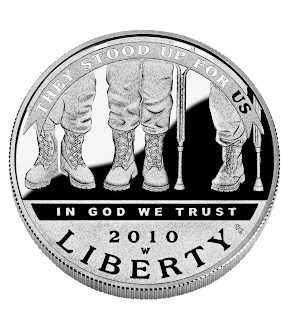Oct 27, 2010 | coin design, commemorative, history
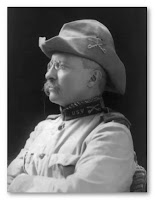 Although Theodore Roosevelt was born of wealth, he was a man of the people. Rather than becoming someone of society, Roosevelt sought to change society. From his days as an asthmatic child using hunting and other physical activities to overcome his weaknesses, his education at Harvard, conquering the Badlands of South Dakota, to a political career that changed nearly every level of government, Roosevelt was the renaissance of American history.
Although Theodore Roosevelt was born of wealth, he was a man of the people. Rather than becoming someone of society, Roosevelt sought to change society. From his days as an asthmatic child using hunting and other physical activities to overcome his weaknesses, his education at Harvard, conquering the Badlands of South Dakota, to a political career that changed nearly every level of government, Roosevelt was the renaissance of American history.
Before Roosevelt was 42, he was a deputy sheriff in the Dakota Territory, Police Commissioner of New York City, U.S. Civil Service Commissioner, Assistant Secretary of the Navy, and Colonel of the Rough Riders for which he was awarded the Medal of Honor. Roosevelt was elected to the New York State Assembly, Governor of New York, and Vice President of the United State. In fact, his nomination as vice president to run with William McKinley by the Republican Party was to get him out of New York because he was reforming the status quo out of existence.
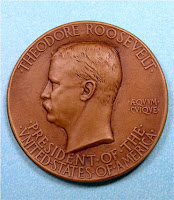 On September 14, 1901, at 42 years and 322 days of age, Roosevelt became the youngest President when McKinley was assassinated (Kennedy is the youngest elected president when he was inaugurated at 43 years, 236 days). As president he was a trust buster, conservationist, and his slogan of “Speak softly and carry a big stick” set the tone for military and foreign policy that even impacts today’s policies. Roosevelt was the first U.S. citizen and sitting to win the Nobel Peace Price for negotiating the 1905 peace treaty ending the Russo-Japanese War.
On September 14, 1901, at 42 years and 322 days of age, Roosevelt became the youngest President when McKinley was assassinated (Kennedy is the youngest elected president when he was inaugurated at 43 years, 236 days). As president he was a trust buster, conservationist, and his slogan of “Speak softly and carry a big stick” set the tone for military and foreign policy that even impacts today’s policies. Roosevelt was the first U.S. citizen and sitting to win the Nobel Peace Price for negotiating the 1905 peace treaty ending the Russo-Japanese War.
Roosevelt initiated the “Golden Age of American Coin Design.” Using his bully pulpit, he held the designs of the U.S. Mint Chief Engraver Charles E. Barber in contempt and ordered coinage whose designs were more than 25 years old to be redesigned. Roosevelt was a fan of sculptor Augustus Saint-Gaudens and asked him to help redesign American coinage.
After Saint-Gaudens died of cancer, Roosevelt continued to look to revitalize U.S. coinage. He seized upon Abraham Lincoln’s 100th birthday to redesign the small cent. He was steered to Victor David Brenner, whose bust of Lincoln was used as the model for the new Lincoln Cent first issued in 1909. Not only was Lincoln the first president to appear on a circulating coin, but Brenner’s obverse is still in use today.
Roosevelt called his coinage redesign his “pet crime”
For all his accomplishments, it is difficult to understand why our 26th President has not been honored on a coin.
Theodore Roosevelt was born on October 27, 1858, 152 years ago today. Happy Birthday, Mr. President! We numismatist thank you for your “pet crime!”
Roosevelt Inaugural Medal design by Augustus Saint-Gaudens courtesy of the Museum of American History.
Oct 22, 2010 | coins, commemorative, history
Starting at the turn of the 19th century, scientists inspired by Benjamin Franklin’s study of electricity started to look at ways that electricity could be generated and its energy turned into light. The idea that a lamp could be created that used electricity for use in coal mines. Oil and gas lamps were credited with causing a rash of explosions in Europe and alternatives were needed.
It started with Sir Humphry Davy, a British chemist who is credited with the discovery of alkali metals whose properties could generate electricity. Davy experimented with different filaments and containers to make a lamp that could be used in the mines. Davy Lamp was not successful, but began a century of experimenting with electricity.

Edison in 1878
Building on a half-century of research, Thomas Edison experimented with different filaments, eventually settling on a carbon filament. Edison held the first successful test on October 22, 1879. It lasted 40 hours. Later, Edison and his team would discover materials that would last over 1,200 hours.
Even though Edison did not invent the lightbulb, his significant improvements to the design of the lightbulb raised public consciousness on the wonder of the electric light branding him as the inventor of the lightbulb. It was one of over 1,300 inventions during a remarkable career.
In 1988, the 105th congress passed the “Thomas Alva Edison Commemorative Coin Act” (Public Law 105-331 [text] [pdf]). The law called for a $1 silver commemorative issued in 2004 to honor the 125th anniversary of the “invention of the lightbulb.”
The design of the 2004 Thomas Alva Edison Commemorative Coin depicts a portrait of Thomas Edison holding an early experimental lightbulb. It was designed by U.S. Mint Engraver Donna Weaver. The reverse depicts Edison’s first lightbulb and designed by John Mercanti. These commemoratives were struck at the Philadelphia Mint and was sold out.
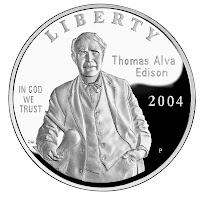
Obverse Designed by Donna Weaver

Reverse designed by John Mercanti
Coin images courtesy of the U.S. Mint.
Oct 14, 2010 | coins, commemorative, legislative
As we know, the U.S. Mint does exactly what it is told by law. In order to understand what the U.S. Mint will do in the future is to follow what coin-related laws are introduced and passed. Watching congress could be a sport in itself but for our purposes, we limit the watching to legislation concerning coin and U.S. Mint. Since congress is in recess until November and the 111th congress getting ready to adjourn for the last time before the 112th congress begins on January 3, 2011, it appeared to be a good time to review their numismatic-related work.
Bills Passed Into Public Law
These are the bills that have passed both houses of congress and sent to the President for his signature.
Girl Scouts USA Centennial Commemorative Coin Act
Introduced by Jack Kingston (R-GA) as H.R.621
Became Public Law No: 111-86 [txt, pdf] on 10/29/09
One coin issued in 2013:
- 350,000 $1 silver coins
Surcharges paid to the Girl Scouts of the United States of America
- $10 per coin for the $1 silver coin
Medal of Honor Commemorative Coin Act of 2009
Introduced by Christopher Carney (D-PA) as H.R.1209
Became Public Law No: 111-91 [txt, pdf] on 11/6/09
Two coins issued in 2011:
- 100,000 $5 gold coins
- 500,000 $1 silver coins
Surcharges paid to the Congressional Medal of Honor Foundation
- $35 per coin for the $5 gold coin
- $10 per coin for the $1 silver coin
Coin Images→Medal of Honor Commemorative $5 Gold Coin — Medal of Honor Commemorative $1 Silver Coin
Star-Spangled Banner Commemorative Coin Act
Introduced by Dutch Ruppersberger (D-MD) as H.R.2097
Became Public Law No: 111-232 [txt, pdf] on 8/16/10
Two coins issued in 2012:
- 100,000 $5 gold coins
- 500,000 $1 silver coins
Surcharges paid to the Maryland War of 1812 Bicentennial Commission
- $35 per coin for the $5 gold coin
- $10 per coin for the $1 silver coin
5-Star Generals Commemorative Coin Act
Introduced by Dennis Moore (D-KS) as H.R.1177
Became Public Law No: 111-262 [txt, pdf] on 10/8/10
Three coins issued in 2013:
- 100,000 $5 gold coins
- 500,000 $1 silver coins
- 750,000 half-dollar clad coins
Surcharges paid to the Command and General Staff College Foundation
- $35 per coin for the $5 gold coin
- $10 per coin for the $1 silver coin
- $5 per coin for the half dollar clad coin
Bills Passed by the House and Referred to the Senate
These are the bills that have gone through the legislative process in the House of Representatives, have been enrolled, and sent to the Senate for their action. Coin bills in the Senate are referred to the Committee on Banking, Housing, and Urban Affairs.
Mother’s Day Centennial Commemorative Coin Act
Introduced by Shelly Capito (R-WV) as H.R.2421
Passed by House on 5/6/10
One coin issued in 2014:
- 400,000 $1 silver coins
Surcharges paid to Susan G. Komen for the Cure and National Osteoporosis Foundation
- $10 per coin for the $1 silver coin
American Eagle Palladium Bullion Coin Act of 2010
Introduced by Denny Rehberg (R-MT) as H.R.6166
Passed by House on 9/29/10
Adds a $25 palladium bullion coin to the American Eagle Bullion Program. The bill requires the design to be as follows:
- Obverse same as Mercury Dime
- Reverse design of the 1907 American Institute of Architects medal
Coin Modernization, Oversight, and Continuity Act of 2010
Introduced by Melvin Watt (D-NC) as H.R.6162
Passed by House on 9/29/10
Requires the U.S. Mint to research minting metals used for coining money. Sets the study length to two years and requires the U.S. Mint to tie the research to Mint production. Bill includes two technical changes:
- Changes the American Eagle Bullion Program to allow the U.S. Mint to divert materials to strike collectibles
- Changes the National Park Bullion program to allow the U.S. Mint change the size of the planchet from 2.5 to 3.0 inches
Sources report that these three bills are expected to pass the Senate during the lame duck session.
Bills Introduced in the House of Representatives
Any member of the House of Representatives can submit a commemorative coin bill. All they have to do is format the bill correctly and drop it into the hopper where the Clerk of the House assigns a bill number and sent to the Speaker of the House who assigns the bill to a committee. Commemorative coin bills are assigned to the Domestic Monetary Policy and Technology subcommittee under the Committee on Financial Services. It is up to the chairman of the committee and subcommittee to determine whether the bill will be scheduled for debate or tabled indefinitely.
Bills not acted upon do not carry over between congresses meaning if they are not passed into law, they will not be part of the 112th congress unless they are introduced during that session. These bills are said that they “died in committee.”
The following bills are not coin or numismatic-related bills but they are of interest to collectors and investors:
Free Competition in Currency Act of 2009
Introduced by Ron Paul (R-TX) as H.R.4248 on 12/9/2009 and referred to the Subcommittee on Commercial and Administrative Law. The basic provisions of this bill is as follows:
- Calls for the elimnation of all taxes on the sale and tranfer of bullion and coins
- Changes the law to allow precious metals to be used as coins or a medium of exchange. This was introduced after the Justice Department stopped the production of the Amero as being illegal.
Coin and Precious Metal Disclosure Act
Introduced by Anthony D. Weiner (D-NY) as H.R.6149 on 9/16/2010 and referred to the House Committee on Energy and Commerce. Bill is intended as a consumer protection law that requires sellers of precious metal coins and bullion to provide additional information to the potential buyer. Sometimes referred to as the Goldline Act since Rep. Weiner has targeted Goldline in his commentary regarding this bill, there are side effects that may impact coin dealers that are not part of Rep. Weiner’s target.
Small Business Paperwork Mandate Elimination Act
Introduced by Dan Lungren (R-CA) as H.R.5141 and referred to the House Committee on Ways and Means. This is the bill that will remove the requirement to report all goods and services purchased in excess of $600 with an IRS 1099 form beginning in 2012 that was part of the health care reform legislation. Almost everyone in almost every industry is in favor of this bill’s passage. Sen. Mike Johanns (R-NE) has introduced S.3578 as a companion bill in the Senate. Sources report that one of the bills will be passed in the lame duck session. However, there is a concern that the President may veto the legislation if the revenues are not made up elsewhere.
The following commemorative coin bills have been introduced and are in committee waiting for action:
- NASA 50th Anniversary Commemorative Coin Act — Introduced by Sheila Jackson-Lee (D-TX) as H.R.255 on 1/7/2009
- Mark Twain Commemorative Coin Act — Introduced by John Larson (D-CT) as H.R.1195 on 2/25/2009
- Revolutionary War and War of 1812 Battlefields Commemorative Coin Act of 2009 — Introduced by Rush Holt (D-NJ) as H.R.2001 on 4/21/2009
- Robert M. La Follette, Sr. Commemorative Coin Act — Introduced by Tammy Baldwin (D-WI) as H.R.2318 on 5/7/2009
- United States Marshals Service 225th Anniversary Commemorative Coin Act — Introduced by John Boozman (R-AR) as H.R.2799 on 6/10/2009
- Ronald Reagan Commemorative Coin Act of 2009 — Introduced by Robert E. Latta (R-OH) as H.R.3341 on 7/24/2009
- Original Saint-Gaudens Double Eagle Ultra-High Relief Bullion Coin Act of 2009 — Introduced by Denny Rehberg (R-MT) as H.R.3405 on 7/30/2009
- National Future Farmers of America Commemorative Coin Act of 2009 — Introduced by Bruce L. Braley (D-IA) as H.R.3464 on 7/31/2009
- National September 11 Memorial & Museum Commemorative Coin Act of 2009 — Introduced by Jerrold Nadler (D-NY) as H.R.3549 on 9/10/2009
- 1863 Gettysburg Campaign Act — Introduced by Todd Russell Platts (R-PA) as H.R.3712 on 10/1/2009
- International Civil Rights Center and Museum Commemorative Coin Act — Introduced by Brad Miller (D-NC) as H.R.3912 on 10/22/2009
- James Monroe Commemorative Coin Act — Introduced by Robert J. Wittman (R-VA) as H.R.4329 on 12/16/2009
- United States Marshals Service 225th Anniversary Commemorative Coin Act — Introduced by John Boozman (R-AR) as H.R.5680 on 7/1/2010
Bills Introduced in the Senate
Article I, Section 7 of the U.S. constitution says “All Bills for raising Revenue shall originate in the House of Representatives.” Since all commemorative coin bills raise revenue, they must originate in the House. However, it is common for senators to introduce bills to influence their House counterparts to introduce a similar bill or they will introduce a companion bill in support. Very few of the coin-related bills introduced in the Senate become law. Those that do become law are amended versions of the House bills passed in the Senate and sent back to the House for a vote—usually with concurrence of the House leadership. This process eliminates the need for a conference committee to reconcile bills.
Coin-related bills introduced in the Senate are assigned to the Committee on Banking, Housing, and Urban Affairs. The following list are the bills that have been introduced in the Senate with the compaion bills that have become law removed:
- Mark Twain Commemorative Coin Act — Introduced by Christopher J. Dodd (D-CT) as S.483 on 2/25/2009
- Original Saint-Gaudens Double Eagle Ultra-High Relief Bullion Coin Act of 2009 — Introduced by Max Baucus (D-MT) as S.758 on 4/1/2009
- Robert M. La Follette, Sr. Commemorative Coin Act — Introduced by Russell D. Feingold (D-WI) as S.945 on 4/30/2009
- Mother’s Day Centennial Commemorative Coin Act — Introduced by John D. Rockefeller (D-WV) as S.1012 on 5/7/200
- Fair Treatment for Precious Metals Investors Act — Introduced by Mike Crapo (R-ID) as S.1367 on 6/25/2009
- National Future Farmers of America Commemorative Coin Act of 2009 — Introduced by Chuck Grassley (R-IA) as S.1553 on 7/31/2009
- Options for Investors through United States Certified Coins Act of 2009 — Introduced by David Vitter (R-LA) as S.1769 on 10/8/2009
- International Civil Rights Center and Museum Commemorative Coin Act — Introduced by Kay Hagan (D-NC) as S.1819 on 10/21/2009
- United States Marshals Service 225th Anniversary Commemorative Coin Act — Introduced by Blanche L. Lincoln (D-AR) as S.2106 on 10/29/2009
- 1863 Gettysburg Campaign Act — Introduced by Arlen Specter (D-PA) as S.3009 on 2/11/2010
- United States Marshals Service 225th Anniversary Commemorative Coin Act — Introduced by Blanche L. Lincoln (D-AR) as S.3572 on 7/13/2010
Aug 22, 2010 | commemorative, legislative
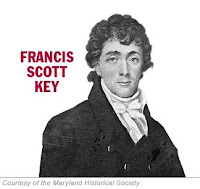 After a rare case of bipartisanship (Senate passed it by unanimous connect and it passed the House of Representatives on a 419-1 vote), the President signed H.R. 2097, Star-Spangled Banner Bicentennial Commemorative Coin Act which become Public Law No. 111-232 ([Text] [PDF]).
After a rare case of bipartisanship (Senate passed it by unanimous connect and it passed the House of Representatives on a 419-1 vote), the President signed H.R. 2097, Star-Spangled Banner Bicentennial Commemorative Coin Act which become Public Law No. 111-232 ([Text] [PDF]).
Some historians call War of 1812 the United State’s second revolutionary war. The primary reason for declaring war on Great Britain was after years of the Royal Navy harassing or capturing merchant ships bound for France. At the time, England was in the middle of the Napoleonic Wars and was trying to prevent France from getting the supplies it needed. This lead to President James Madison to give a speech to congress explaining England’s actions. Although Madison did not call for a declaration of war, the Democrat-Republican lead congress voted to declare war on Great Britain (79-49 in the House, 19-13 in the Senate). Madison signed the declaration on June 18, 1812.
During the march to Baltimore after the British attack on Washington, D.C., the British took Dr. William Beanes as a prisoner. Beanes was imprisoned in Baltimore as the Royal Navy gathered forces for their attack on Fort McHenry in Baltimore Harbor.
Word of Beanes’s capture reached Francis Scott Key, an accomplished lawyer, prosecutor, poet, and friend of Dr. Beanes. Key, who was known as a skilled negotiator and a very temperate man, was asked by the Army to accompany prisoner exchange agent Colonel John Stuart Skinner to Baltimore to secure the release of Dr. Beanes. On September 7, 1814, Key and COL Skinner dined with British officers abroad the HMS Tonnant to negotiate the release of prisoners. ALthough Beanes was released, the British would not let the men leave the ship because they had heard about the British plans to attack Fort McHenry.
That night, Key, Skinner, and Beanes watched as the Royal Navy bombarded Fort McHenry. As the smoke cleared on the morning of September 14, 1814 after 25-hours of bombardment, Key was able to see the American flag still flying over Fort McHenry. Key was so moved by the sight that after returning home, he wrote the poem “The Defence of Fort McHenry.” The poem was published in the Baltimore Patriot on September 20, 1814.
When the poem was published, it was noted that it could be sung to the music of The Anacreontic Song, the official song of the Anacreontic Society. Shortly after publication, the music and words were published together by Thomas Carr and renamed the Star-Spangled Banner.
Throughout the 19th century, it became popular to sing this poem on July 4th to commemorate Independence Day. Its first official recognition came in 1889 when Secretary of the Navy Benjamin F. Tracy signed an order making The Star-Spangled Banner the official tune to be played at the raising of the flag.
Although it was popular that The Star-Spangled Banner be played when raising the flag, it did not receive an official declaration until 1916 when President Woodrow Wilson signed an executive order saying that it be played at all military and other appropriate diplomatic occasions. President Herbert Hoover signed the law making The Star-Spangled Banner the official national anthem of the United States on March 3, 1931.
The Star-Spangled Banner Commemorative Coin Act commemorates the bicentennial of the War of 1812 and the Star-Spangled Banner by issuing commemorative coins in 2012. These coins are to have a design “emblematic of the War of 1812 and particularly the Battle for Baltimore that formed the basis for the Star-Spangled Banner.” The program will include 100,000 $5 gold coins and 500,000 $1 silver coins.
Sales of these coins will include a $35 surcharge for the $5 gold coin and $10 for the $1 silver coin (a total of $8.5 million if the coins sellout), that will be paid to the Maryland War of 1812 Bicentennial Commission “for the purpose of supporting bicentennial activities, educational outreach activities (including supporting scholarly research and the development of exhibits), and preservation and improvement activities pertaining to the sites and structures relating to the War of 1812.”
The Maryland War of 1812 Bicentennial Commission is planning quite a few events through the anniversary of Key writing “In Defence of Fort McHenry.” Check their website for schedule and plan a trip to help celebrate.
Jun 11, 2010 | celebration, coins, commemorative
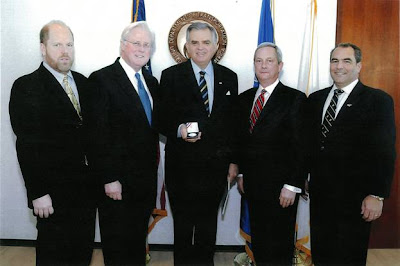
Secretary of Transportation Ray LaHood receives a 2010 American Veterans Disabled for Live Silver Dollar to thank the U.S. Department of Transportation for its support of street and road infrastructure projects surrounding the site of upcoming American Veterans Disabled for Life Memorial in Washington, D.C. The American Veterans Disabled for Life Memorial will be the country’s first national memorial dedicated to living and deceased disabled veterans and is planned for a site within view of the U.S. Capitol. For more information on the Memorial, visit www.avdlm.org. Silver dollars can be ordered from the U.S. Mint with proceeds benefitting the Memorial.
Pictured, left to right (above):
Peter Dickinson, Disabled American Veterans; Ray McGrath, Downey McGrath Group; Secretary Ray LaHood; Barry Owenby, Disabled Veterans LIFE Memorial Foundation; Joseph Violante, Disabled American Veterans.
Dec 26, 2009 | cents, coins, commemorative, dollar, quarter, US Mint
Around this time last year, I wrote that 2009 would be quite a year. As 2009 comes to an end, I know why I am not a prognosticator. With the down economy, the convergence of so many coin programs, and the performance questions of the US Mint it is difficult to call 2009 a successful year; yet it was not a failure.
Some of the success of this year included the 2009 Ultra High Relief Gold Coin, the District of Columbia and US Territories Quarters, and the Lincoln Bicentennial One Cent program. Although finding the cents and quarters have been difficult to find in change, these new coins had nice designs and was a chance for people to learn about Lincoln’s life and the history of our territories.

 As the Lincoln Cent enters its 101st year of production, it will be given a new reverse. The Union Shield was selected as the symbol of a united country. The shield is featured in many of the frescos painted by Constantino Brumidi throughout the US capitol. Brumidi was the Artist of the capitol during Abraham Lincoln’s presidency. The fresco shown here is one of the eight trophy panel from room S-128 (from the Senate side) of the capitol. It was design by Brumidi and painted by English artist James Leslie.
As the Lincoln Cent enters its 101st year of production, it will be given a new reverse. The Union Shield was selected as the symbol of a united country. The shield is featured in many of the frescos painted by Constantino Brumidi throughout the US capitol. Brumidi was the Artist of the capitol during Abraham Lincoln’s presidency. The fresco shown here is one of the eight trophy panel from room S-128 (from the Senate side) of the capitol. It was design by Brumidi and painted by English artist James Leslie.
Starting in 2010, the US Mint will begin the American the Beautiful Quarters Program. It will be a program with 56 quarter-dollar coins featuring designs depicting national parks and other national sites. Although this program might be overkill, the designs show that the program has the promise to show new and interesting designs. The first five quarters for 2010 will honor Hot Springs National Park in Arkansas, Yellowstone National Park in Wyoming, Yosemite National Park in California, Grand Canyon National Park in Arizona, and Mount Hood National Forest in Oregon. It will be interesting to see if this program will catch on.
 In the second year of the Native American $1 Coin program, the theme for the 2010 reverse is “Government–The Great Tree of Peace.” The reverse design features five bound arrows and the Hiawatha Belt. Hiawatha was the helper to the Great Peacemaker who negotiated peace amongst the Seneca, Cayuga, Onondaga, Oneida, and Mohawk tribes in the area now known as New York state. The alliance was known as Haudenosaunee, the Iroquois Confederacy, and is featured on the reverse. The words “Great Law of Peace” is also on the reverse to honor the constitution that created the confederacy. It is a wonderful design that follows up the great design of 2009.
In the second year of the Native American $1 Coin program, the theme for the 2010 reverse is “Government–The Great Tree of Peace.” The reverse design features five bound arrows and the Hiawatha Belt. Hiawatha was the helper to the Great Peacemaker who negotiated peace amongst the Seneca, Cayuga, Onondaga, Oneida, and Mohawk tribes in the area now known as New York state. The alliance was known as Haudenosaunee, the Iroquois Confederacy, and is featured on the reverse. The words “Great Law of Peace” is also on the reverse to honor the constitution that created the confederacy. It is a wonderful design that follows up the great design of 2009.
Continuing the Presidential $1 Coins, 2010 will include coins for Presidents Millard Fillmore, Franklin Pierce, James Buchanan, and Abraham Lincoln. We may see an increase of interest in these coins with the introduction of the dollar honoring Lincoln as we pass the (ho-hum) early 19th century presidents.
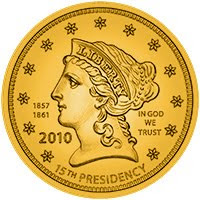 Along with the Presidential dollars will be the First Spouse Gold Coins. Along with the presidents will be gold coins to honor Abigail Fillmore, Jane Pierce, Buchanan’s Liberty, and Mary Todd Lincoln. President James Buchanan was not married. His first spouse coin will be a reproduction of the Liberty Head Quarter Eagle designed by Christian Gobrecht minted and issued from 1840 through 1907. The reverse design depicts the future President as a boy working as a bookkeeper in his family’s small country store design by Artistic Infusion Program Associate Designer David Westwood.
Along with the Presidential dollars will be the First Spouse Gold Coins. Along with the presidents will be gold coins to honor Abigail Fillmore, Jane Pierce, Buchanan’s Liberty, and Mary Todd Lincoln. President James Buchanan was not married. His first spouse coin will be a reproduction of the Liberty Head Quarter Eagle designed by Christian Gobrecht minted and issued from 1840 through 1907. The reverse design depicts the future President as a boy working as a bookkeeper in his family’s small country store design by Artistic Infusion Program Associate Designer David Westwood.
To round out circulating coinage, no changes are in store for the nickel, dime, and half-dollar.
Commemorative coins for 2010 will include the 2010 Boy Scouts of America Centennial Commemorative Coin and the American Veterans Disabled for Life Commemorative Coin. The Boy Scout commemorative celebrates the 100th anniversary of the Boy Scouts of America. The program will produce 350,000 silver dollar coins with the $10 surcharge will be paid to National Boy Scouts of America Foundation who issues grants to local council for the extension of scouting in hard-to-serve areas.
The American Veterans Disabled for Life will also produce 350,000 silver dollars in proof and uncirculated version to honor disabled veterans. The $10 surcharge will be paid to the Disabled Veterans’ LIFE Memorial Foundation to support the construction of the American Veterans Disabled for Life Memorial in Washington, DC.
Considering what happened this year, it will be difficult to predict what will happen to the American Eagle Bullion and American Buffalo 24-Karat Gold coins. Because of how the law is written, American Eagle bullion will be produced but we are not sure whether American Eagle proof coins will join them. I hope the proof coins will be produced in 2010, but with the current Mint administration, we will not know until they announce a commitment to their production.
I hope 2010 sizzles as much as 2009 fizzled!
Fresco image from Constantino Brumidi: Artist of the Capitol.
Coin images courtesy of the US Mint.
Nov 6, 2009 | coins, commemorative, policy, US Mint
As part of the restructuring of the US Mint, the area of commemorative coins have to be a significant concern. With both the classic and modern commemoratives, congress could not help itself by using commemorative coins as a form of fundraising for pet causes. While some of the beneficiaries of the funds are worthy, others have caused significant controversy. Additionally, there were commemorative programs that have lost money for the US Mint causing more losses than what has been seen in the cent and nickel.
The first reform in commemorative coinage would be that no commemorative would be struck for the sole purpose of raising money for any organization. Regardless of how worthy the organization may be, the association of the commemorative with fundraising taints the process. Thus, this proposed reform recommends that no commemorative coin may be proposed with the purpose of fundraising.
Once the commemorative coin has been approved, related groups may petition congress to attach their organization to the commemorative for fundraising purposes. If congress approves, the organization will be paid for the profits beyond the cost of manufacturing, packing, and distribution of the coin. The US Mint must be able to recover their costs before any money is distributed to the approved organization. Payments will be made quarterly after the US Mint has broken-even. As part of this plan, the US Mint holds back 5-percent of the dispersal in order cover future expenses. When the sales of the commemorative coins are complete, the US Mint’s costs will be recalculated and the remainder will be paid to the approved organization.
Before choosing an organization for fundraising, the commemorative coin must be selected. Since congress has bungled this over the years, congress should no longer select topics or how the program is to run. As part of the reformed commemorative coin laws, the congress sets parameters for how commemorative programs and leaves the decisions to the Citizens Coinage Advisory Committee. When the CCAC makes their selection, the process will be limited to something of national interest. It may be something relating to history (e.g., War of 1812), the anniversary of a government institution or program, someone of national historical significance, or a building of national importance (e.g., the Capital Building, White House). The commemorative must be something representative of the national interest.
All commemoratives will be proof strikes. There seems to be no purpose to uncirculated commemorative coins nor is there a purpose for clad commemorative. Commemorative programs may contain up to four coins with the priority being $1 silver, $10 gold, half-dollar silver, and $5 gold. In this scenario, if the commemorative program is to only have three coins, then the $5 gold coins would not be used. If the commemorative is used for a fundraiser, the US Mint will add a $5 premium for the half-dollar, $10 premium for the dollar, $25 premium for the $5 gold coin, and the $35 premium for the $10 coin.
Because it may be impossible for the egos in congress to remove themselves from the commemorative process, the law should allow that they be given the ability to vote in one commemorative program per year. As opposed to their current practice, a congressional commemorative program may specify everything except the design and where the coins will be struck. The design will be created by the CCAC and the US Mint engravers to match the theme of the program and the branch mint used to strike the coins will be selected by the US Mint in a manner to make efficient use of the facilities.
As part of the transition, any commemorative program passed by congress prior to the restructuring will be issued as required by the enacted law. However, those commemoratives will count against the one program that congress is allocated per year.
Fixing the commemorative coin program is a combination of making it relevant and removing the fundraising aspect of the programs. With the compromise of allowing congress one commemorative program a year and giving them the ability to add a controlled fundraising aspect after the fact, this should prevent commemorative coins from becoming irrelevant.
The restructuring continues next with the bullion programs.
Sep 29, 2009 | coins, commemorative, history
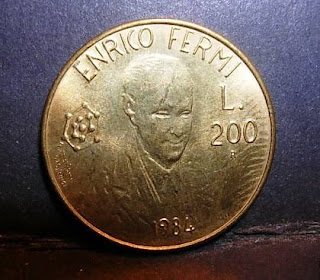 Today, we wish a Happy Birthday to Enrico Fermi. If he was still alive, Fermi would be 108 years old.
Today, we wish a Happy Birthday to Enrico Fermi. If he was still alive, Fermi would be 108 years old.
Fermi was a Nobel Laureate physicist who is commonly credited with harnessing the nuclear power. Fermi won the Nobel Prize in Physics in 1938 “for his demonstrations of the existence of new radioactive elements produced by neutron irradiation, and for his related discovery of nuclear reactions brought about by slow neutrons” This work made him an important contributor to the Manhattan Project.
Fermi, who is considered one of the premier scientists of the 20th century, was granted 14 patents and was instrumental in the development of nuclear energy. He is called the father of nuclear energy.
In 1984, the Republic of San Marino,the oldest sovereign state and constitutional republic in the world, issued a 200 Lire commemorative coin (KM# 166) honoring Fermi on the 30th anniversary of his death. The coin is made of copper-nickel and is worth about $2.50 as an uncirculated coin.
Happy Birthday, Enrico, and thank you for sharing your work with the world!
Sorry, I forgot where I found the picture to give that person credit.
May 6, 2009 | commemorative, US Mint, video
One thing I like about numismatics is that coins, currency, tokens, and other ephemera can be used to teach history. Along with teaching history, they can be used to raise money for worthy causes. One such coin is the 2009 Louis Braille Bicentennial Silver Dollar, the first coin with readable braille. The $10 surcharge, up to a maximum of $4 million will be paid to the National Foundation for the Blind to promote braille literacy.
In order to understand where your money will go, NFB produced a video titled Change with a Dollar to explain their Braille literacy initiative and how the money raised from the sales of the Braille Commemorative will help their cause. I thought my readers would be interested in this video:
NFB also produced a one minute commercial titled I Can Do More: Louis Braille Bicentennial Silver Dollar which can be seen…
Both proof and uncirculated coins are available from the US Mint if you want to help NFB’s effort to promote Braille literacy.
Apr 3, 2009 | commemorative, legislative
With the economic crisis, failing of industries, the fighting of two wars, and partisan bickering, some members of congress has found time to author and submit bills to authorize the striking of commemorative coins. Many of these bills have merit, but the timing is in question.
For the 111th Congress, the House Committee on Financial Services set a rule that requires a coin bill to be co-sponsored by 75-percent of the members. Considering that there are two open seats, the committee is requiring that the bill have 324 cosponsors. Currently, no coin bill has that many sponsors. I am sure as the session continues, there will be some movement on a few of these bills. There are no similar rules in the Senate.
Here is a rundown of the commemoratives legislation that have been introduced in congress:
H.R. 255: To require the Secretary of the Treasury to mint coins in commemoration of the 50th anniversary of the establishment of the National Aeronautics and Space Administration. Introduced by Rep. Rep Sheila Jackson-Lee (D-TX) was introduced on January 7, 2009. If passed, the bill should raise more than $5 million that would benefit the NASA Family Assistance Fund, the Dr. Ronald E. McNair Educational (D.R.E.M.E.) Science Literacy Foundation, the Challenger Center for Space Science Education, and the Steven F. Udvar-Hazy Center of the National Air and Space Museum.
H.R. 621 and S. 451: To require the Secretary of the Treasury to mint coins in commemoration of the centennial of the establishment of the Girl Scouts of the United States of America. Introduced by Rep. Jack Kingston (R-GA) in the House on January 21, 2009 and Sen. Susan Collins (R-ME) in the Senate on February 23, 2009. If passed, the potential $3.5 million paid in surcharges will be given to the Girl Scouts of America.
H.R. 1177 and S. 455: To require the Secretary of the Treasury to mint coins in recognition of 5 United States Army 5-Star Generals, George Marshall, Douglas MacArthur, Dwight Eisenhower, Henry “Hap” Arnold, and Omar Bradley, alumni of the United States Army Command and General Staff College, Fort Leavenworth, Kansas, to coincide with the celebration of the 132nd Anniversary of the founding of the United States Army Command and General Staff College.. Introduced by Rep. Dennis Moore (D-KS) in the House on February 25, 2009 and Sen. Pat Roberts (R-KS) in the Senate on February 23, 2009. If all of the proposed coins sold out, the $12.25 million in surcharges will be paid to the Command and General Staff College Foundation.
H.R. 1195 and S. 483: To require the Secretary of the Treasury to mint coins in commemoration of Mark Twain. Introduced by Rep. John Larson (D-CT) in the house and by Sen. Chris Dodd (D-CT) in the Senate on February 25, 2009. The potential $8.5 million in surcharges will be divided up between the Mark Twain House & Museum in Hartford, Connecticut; he Mark Twain Project at the Bancroft Library of the University of California, Berkeley, California; the Center for Mark Twain Studies at Elmira College, New York; and the Mark Twain Boyhood Home and Museum in Hannibal, Missouri.
H.R. 1209: To require the Secretary of the Treasury to mint coins in recognition and celebration of the establishment of the Medal of Honor in 1861, America’s highest award for valor in action against an enemy force which can be bestowed upon an individual serving in the Armed Services of the United States, to honor the American military men and women who have been recipients of the Medal of Honor, and to promote awareness of what the Medal of Honor represents and how ordinary Americans, through courage, sacrifice, selfless service and patriotism, can challenge fate and change the course of history or the short title of Medal of Honor Commemorative Coin Act of 2009. Introduces by Rep. Chris Carney (D-PA) on February 26, 2006 and currently with 203 sponsors. If passed, the potential $8.5 million in surcharges would be paid to the Congressional Medal of Honor Foundation.
S. 653: A bill to require the Secretary of the Treasury to mint coins in commemoration of the bicentennial of the writing of the Star-Spangled Banner. Introduces by Sen. Ben Cardin (D-MD) and Sen. Barbara Mikulski (D-MD) on March 19, 2009. The potential $8.5 million in surcharges will be paid to the Maryland War of 1812 Bicentennial Commission.
All bills introduced in the House of Representatives have been referred to the House Committee on Financial Services. Those introduced in the Senate are referred to the Committee on Banking, Housing, and Urban Affairs.
Although Theodore Roosevelt was born of wealth, he was a man of the people. Rather than becoming someone of society, Roosevelt sought to change society. From his days as an asthmatic child using hunting and other physical activities to overcome his weaknesses, his education at Harvard, conquering the Badlands of South Dakota, to a political career that changed nearly every level of government, Roosevelt was the renaissance of American history.
 On September 14, 1901, at 42 years and 322 days of age, Roosevelt became the youngest President when McKinley was assassinated (Kennedy is the youngest elected president when he was inaugurated at 43 years, 236 days). As president he was a trust buster, conservationist, and his slogan of “Speak softly and carry a big stick” set the tone for military and foreign policy that even impacts today’s policies. Roosevelt was the first U.S. citizen and sitting to win the Nobel Peace Price for negotiating the 1905 peace treaty ending the Russo-Japanese War.
On September 14, 1901, at 42 years and 322 days of age, Roosevelt became the youngest President when McKinley was assassinated (Kennedy is the youngest elected president when he was inaugurated at 43 years, 236 days). As president he was a trust buster, conservationist, and his slogan of “Speak softly and carry a big stick” set the tone for military and foreign policy that even impacts today’s policies. Roosevelt was the first U.S. citizen and sitting to win the Nobel Peace Price for negotiating the 1905 peace treaty ending the Russo-Japanese War.



